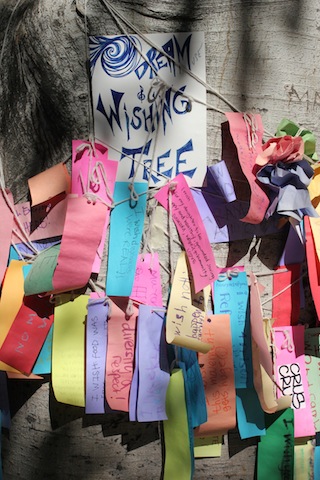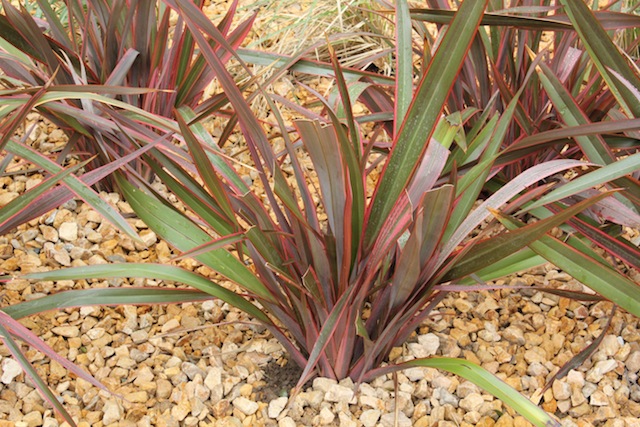Mr Garcetti, tear out this lawn
Posted on | October 29, 2011 | 10 Comments

Yesterday the Los Angeles Times ran an editorial calling for the end of the Occupy LA encampment around City Hall. Among the reasons given were, “They’re killing the lawn in one of downtown’s rare green spaces, which will have to be replaced at taxpayer expense, and they may be damaging City Hall’s majestic fig trees.”
As one of the paper’s garden writers, I beg to differ. Having been to Occupy LA on Thursday, I can see that the encampment is, indeed, acting as human sheet mulch, a powerful technique for removing lawn. Yet once it’s killed, why replace it? Killing the lawn in a water-strapped region is one of the most beneficial things that any citizen can do. The water utility run by the Council inside City Hall has been paying rebates for home owners to do just that for several years now. That Occupy LA is smothering lawn for them should be regarded as an opportunity. That City Hall Facilities has turned off the sprinklers to the lawn is a good thing; traditionally they have inundated the ground so deeply that mushrooms grew. Reportedly the reason for the waste wasn’t for public enjoyment of the lawn, but so homeless couldn’t lounge on it.
As for the protestors hogging green space, there is a quarter of an acre of open lawn one block away by police headquarters.
As for the majestic figs suffering, the old trees will do just fine without irrigation for a couple of cool months in the fall. Moreover, using lawn sprinklers is not an ideal way to irrigate trees. Time for drip! As a plus, curtailing the chronic overwatering of the trees will reduce fast growth, which will reduce maintenance costs. If the worry is about air to feeder roots, a simple request to camp organizers could probably elicit some action. But this is a temporary camp.
Ultimately, the camp will move. It will rain. There will be a raid. Something will happen. But in the meantime, the Los Angeles City Council should embrace this moment to replace the lawn with native gardens. The latter are more beautiful. They celebrate the fragrant and hardy plants that can survive here without daily watering. They require none of the expensive and polluting grooming required by lawn. This is the time for City Hall to reject a style of horticulture synonymous with environmental collapse and adapt a new, sustainable ethos. There are plenty of people camped down there without jobs who could not only use them but who, with a little imagination, could be mobilized to replant wet gardens into more sustainable ones.
And so, consider this my addition to the Occupy LA Dream & Wishing Tree: May protestors camp long enough that they indeed snuff the lawn around the Los Angeles City Hall. Then, may the City Council not only thank them, but also seize the moment to remove what remains of the cynical green skirt around their high white tower.
Note re: Comments. All feedback, positive and negative, is appreciated and respected. However, to avoid the brutishness that easily happens when anonymity is involved, could those wishing to have their comments published please identify themselves with more than a first name and pseudonymous Gmail account? To those whose comments have not been published, please try again, please keep it civil and please identify yourselves.
The Dry Garden: Especially everything
Posted on | October 28, 2011 | No Comments
 Last winter the Los Angeles County Arboretum and Botanic Garden asked what we the public wanted from it. The arboretum held workshops and even hired a professional to run up an online questionnaire. Last month, it published a summary of our responses.
Last winter the Los Angeles County Arboretum and Botanic Garden asked what we the public wanted from it. The arboretum held workshops and even hired a professional to run up an online questionnaire. Last month, it published a summary of our responses.
This much can be said about us: We’re not picky. We want everything. According to the new strategic plan, we want a prettier entrance, better signs and more fabulous gift shop. We want to save water and to celebrate the existing water-glugging collection of plants, while perhaps “de-accessioning” a few old soldiers. We want to emphasize food plants for kids and to preserve a lovely collection of native oaks up the knoll. We want a first-class library with the right kind of onramp to the information superhighway. Did we mention we want invasive plants contained? We do. We also want spiffo management and a fine-tuning of the relationship between the nonprofit foundation and the county officials who, in an occasionally uneasy partnership, run the place.
Click here to keep reading about the Arboretum’s new strategic plan in the Los Angeles Times.
Tags: chance of rain > Emily Green > Los Angeles County Arboretum and Botanic Garden > Los Angeles Times
Occupy outdoors
Posted on | October 24, 2011 | 1 Comment
If proof were needed why I am not a professional photographer, this post is it. But somehow I had to salute a weekend spent at two delightful events — the Los Angeles Community Garden Council gathering of community organizers from all over the LA Basin and the fall festival at Rancho Santa Ana’s Grow Native Nursery at the VA Hospital in Westwood. Both were packed with the best kind of people — gardeners. Both had too many good speakers to count, including LA’s leading horticulturist Lili Singer, seed saver David King, mycologist and Victory Gardener nonpareil Florence Nishida, and Tim Dundon, provisioner of craptonite (aka composted stable manure) to the Foothills. Dundon, it should be added, didn’t lecture but performed “Born to be Wild” while stamping a hoe. The picture is out of focus because I was dancing while taking it. Jeff Spurrier will be covering the council meeting in the penultimate installment of his Wednesday series Community Gardens Dispatch in the Home Section of the Los Angeles Times. For full listings of garden events, including a course by Singer this weekend on native garden basics at the Theodore Payne Foundation, check Lisa Boone’s Monday datebook column.
The Dry Garden: Being John Goodman
Posted on | October 21, 2011 | 2 Comments

Left to their own devices, these newly planted New Zealand flaxes, called Phormium 'Sea Jade,' would each reach five feet in diameter -- fast. They've been put in a new public garden one-foot-on-center to create a quick sense of fill. Nurseries and landscape designers take the praise and money and then run. The facilities manager who inherits this garden, or the homeowner who innocently emulates it, will be left with an ensuing maintenance nightmare.
The single hardest thing to remember in fall planting season is restraint. After summer dormancy, everything looks so fresh. Salvias are pushing out their autumn blooms. We gardeners are full of pent-up expectation. Everything feels possible! Many things are. Keep that elation. Just resist the urge to crowd young plants during installation, a temptation so strong that almost everyone does it.
The problem may be that we treat young plants like babies, which in some ways they are. Like us, they start small and then grow. But we replace cribs with twin beds and twin beds with double beds and may even redo the basement so a 6-foot-tall baby can have a queen. With plants, you have to start out envisioning a queen-sized bed for the newborn or, in the case of many shrubs and woody perennials, you can easily end up with the horticultural equivalent of John Goodman in a crib.
Click here to keep reading about plant spacing in The Dry Garden in the Los Angeles Times.
‘Dry’ or ‘wild’ winter for Southern California
Posted on | October 20, 2011 | 1 Comment

“For the second winter in a row, La Niña will influence weather patterns across the country,” reports the National Oceanic and Atmospheric Administration, “but as usual, it’s not the only climate factor at play. The ‘wild card’ is the lesser-known and less predictable Arctic Oscillation …”
Click here to keep reading NOAA’s winter outlook published today.
By way of spoiler, the predictions are dry for the already fried Southwest, wet for the already soaked Northwest and Northeast, and vague for Southern California, leaning towards dry. If it’s dry the way last year was dry in Los Angeles, we could get near record rainfall.
« go back — keep looking »

